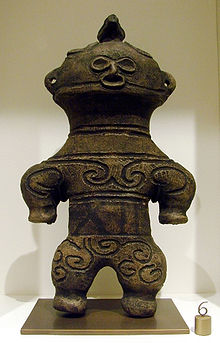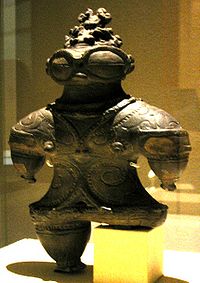- Dogū
-
Dogū (土偶) are small humanoid and animal figurines made during the late Jōmon period (14,000–400 BCE) of prehistoric Japan.
Contents
Characteristics
Most of the European figurines have big eyes, small waists, and wide hips of females and are considered by many to be representative of goddesses. Many have the large abdomens associated with pregnancy, suggesting that the Jomon considered them mother goddesses. According to the Metropolitan Museum of Art, these figurines "suggest an association with fertility and shamanistic rites".[1] Made from clay, these figurines were fashioned into fascinating shapes. The dogū tend to have large faces, small arms and hands and compact bodies. Some appear to wear goggles or have "heart-shaped" faces. Most have marks on the face, chest and shoulders, which suggest tattooing and probable incision with bamboo.
Dogū come entirely from the Jōmon period and do not continue to the Yayoi period. As for Jōmon pottery, Dogū has various styles by exhumation area and generation. According to the National Museum of Japanese History, the total number found throughout Japan is approximately 15,000. Most of the Dogū have been found in East Japan and it is rare to find one in West Japan.
The purpose of the Dogū remains unclear but, most likely, the Dogū acted as effigies of people, that manifested some kind of sympathetic magic. For example, it may have been believed that illnesses could be transferred into the Dogū, then destroyed, clearing the illness, or any other misfortune.
Shakōki-dogū
Shakōki-dogū (遮光器土偶) are dogū created in the Jōmon era, and are so well-known that when most Japanese hear the term dogū, this is the image that comes to mind. The name "shakōki" (literally "light-blocking device") comes from the resemblance of the figures' eyes to traditional Inuit snow goggles. Another distinguishing feature of the objects are the exaggerated (and possibly feminine[citation needed]) buttocks, chest and thighs. Furthermore, the abdomen is covered with patterns, many of which seem to have been painted with vermilion. The larger figures are hollow, presumably in order to prevent cracking during the firing process.[citation needed]
Unbroken figures are rare, and most are missing an arm, leg or other body part. In many cases, the parts have been cut off. One theory is that parts of the figures may have been cut off in fertility rituals[citation needed].
These types of dogū have been found in the Kamegaoka Site in Tsugaru, Aomori Prefecture; the Teshiromori Site in Morioka, Iwate Prefecture; the Ebisuda Site in Tajiri, Miyagi Prefecture; and the Izumisawa Kaizuka Site in Ishinomaki, Miyagi Prefecture. All the sites listed have been designated as Important Cultural Properties.
Dogū types
- "heart shaped (or crescent-shaped eyebrow) type" figurine
- "horned-owl type" figurine
- "goggle-eyed type" figurine
- "pregnant woman type" figurine etc.
In popular culture
- The Digimon Shakkoumon is based on a Shakkoudogū.
- The Claydoll Dopant from Kamen Rider Double is based on a Shakkoudogū.
- In Chōriki Sentai Ohranger, OhYellow pilots the Dogū Lander. The mecha is brought into the US series Power Rangers Zeo, renamed Zeo Zord 2.
- Pikarime of the Shakōkidogū from Tensou Sentai Goseiger is based on Shakkoudogū.
- The character Himiko from Warriors Orochi 2 uses a pair of clay Dogū as her weapons.
- The Yu-Gi-Oh! card Maharaghi and Carat Idol is similar to a Shakkoudogū; while in the same game, the card Orichalcos Shunoros is directly based on it.
- Kodai Shojo Doguchan's protagonist is a big breasted superheroine named Dogu-Chan with a motif based on the dogū statue. Her companion, Dokigoro, is a dogū statue variety dubbed "The Spaceman".
- The boss of the intro stage in Megaman ZX Advent has design elements of a goggle-eyed dogū.
- A dogū enemy appears in the game Okami.
- A dogū appears at Mt. Mikage in Golden Sun: The Lost Age. It is deemed a Dancing Idol. It reappears in Golden Sun: Dark Dawn, as well as a giant dogū connected to the Apollo Lens. This is in conjuncture with Izumo being the Parallel of Japan on Weyard.
- It appears in Naruto Shippuden 4: The Lost Tower as Mukade's ninja puppet army.
- In the Bakugan series Clayf resembles these figures.
- In Clannad Tomoya asks Mei to get him a dogū.
- The Pokémon Baltoy and Claydol are based on the dogū.
- Huitzil's form in "Darkstalkers is modeled after dogu figurines from the Jimon period of Japan's history.
- Arahabaki, a prominent deity of the Kofun period, appears as an iron cast of this kind in the Megami Tensei video game series. This may be a traditional representation of the now demonized deity.
- The Spectrobes series also consist of monster which based on dogū known as Danawa.
See also
References
External links
- Tokyo National Museum
- The National Museum of Japanese History
- Dogū from the Jōmon period, a photographic imagery database—Tokyo University, Japan
- Review of recent exhibition of Dogū at the Tokyo National Museum
Styles of Japanese pottery and porcelain 
Agano · Bizen · Dogū · Hagi · Haji · Haniwa · Imari · Jōmon Pottery · Kakiemon · Karatsu · Kutani · Mino (also Oribe) · Nerikomi · Onda · Ōtani · Raku · Ryumonji · Satsuma · Seto · Shigaraki · Shino · Sōma · Sue · Takitori · Tamba · Tobe · Tokoname · Yokkaichi-Banko
See also: Kintsugi · Shino (glaze) · Tenmoku Categories:
Categories:- Archaeological artefact types
- Japanese pottery
- Japanese traditional dolls
- Jōmon period
Wikimedia Foundation. 2010.



